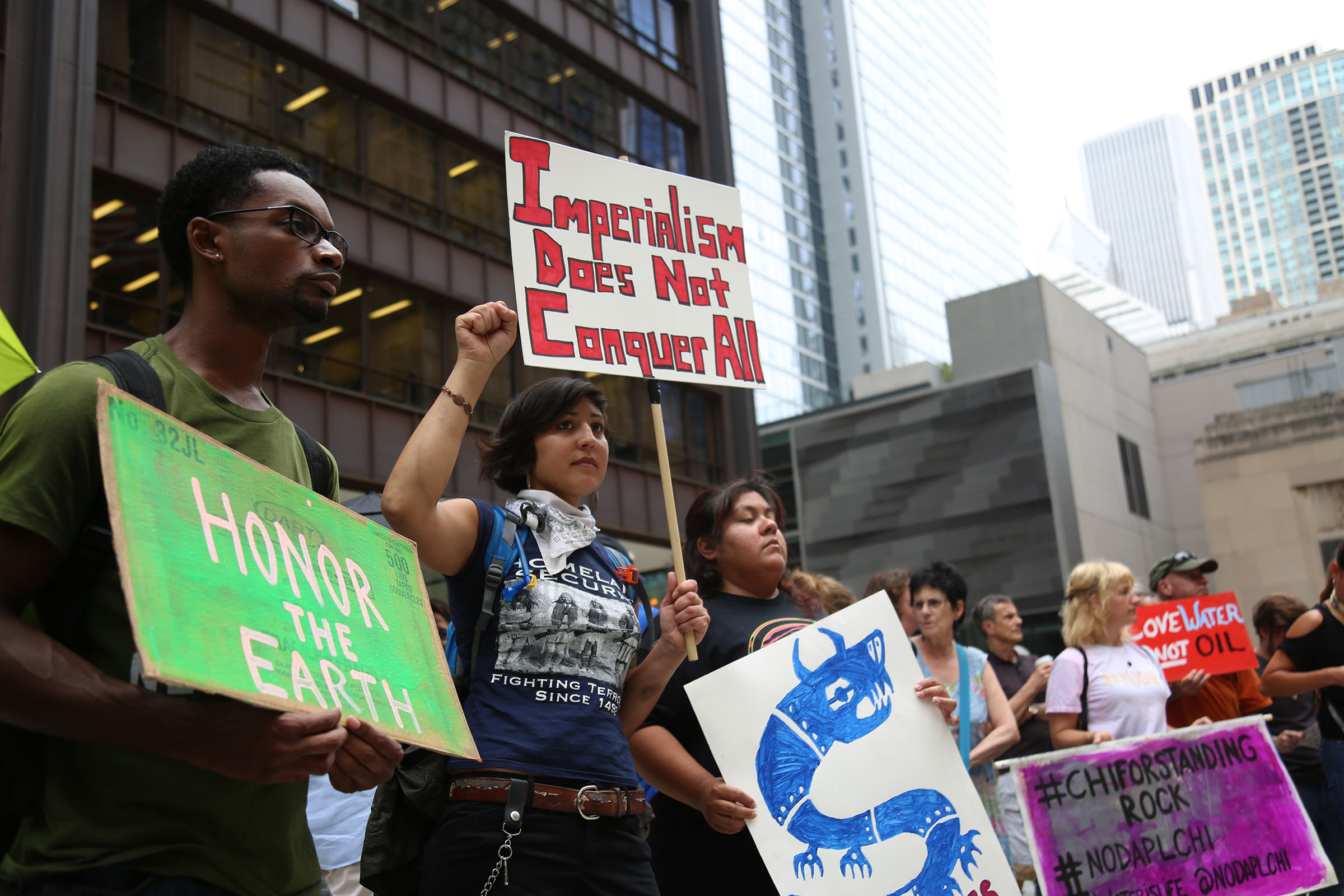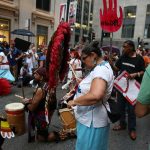
On September 9, protesters gathered in the center of the Daley Plaza to provide moral support for the Standing Rock Sioux Nation’s efforts to stop the construction of the North Dakota Access Pipeline. The people of North Dakota’s Standing Rock reservation have been in a legal battle with the Army Corps of Engineers since they approved a 1,100-mile oil pipeline in July. The pipeline’s developers expect the project to be in service by the end of 2016, and they predict it will haul about 470,000 barrels of oil a day.
The tribe argues the pipeline will threaten their only water source and that it would cut through sacred burial sites. They also contend they should have been consulted before the pipeline was approved.
Before the march began, smoke clouds of sage perforated the street. Customers exiting a nearby Burger King and Dunkin Donuts were greeted by a rally of people chanting, “Water is Life!” and men carrying NODAPL signs.
The protesters marched up to the Federal Reserve Bank of Chicago, and paused on the steps. A few feet away from the building, barefooted men and women in colorful headwraps and beaded anklets performed a ceremonial prayer. They danced around burning sage, a glass bowl filled with water and flowers, and conch shells.
“Sage is what our ancestors used to ward off bad spirits,” a woman told me. She was carrying sage in a conch shell. “We still use the medicine today. It has to be used for ceremonial prayers to represent one of the four earth elements.”
The protest also integrated several artistic and spiritual elements, with dancers and musicians among the marchers.
A drummer, kneeling in wet pavement, positioned himself a few inches away from the dancers. Extending from his book bag was a feather-adorned poster reading, “El Agua es Sagrada,” which translates to “Water is Sacred.”
The chairman of the Standing Rock Sioux Nation, Dave Archambault II, said on September 20 that the United States failed to recognize the rights and wellbeing of his tribe. He has called on the United Nations Human Rights Council to address the pipeline’s construction.
The crowd demonstrating in Chicago was just one of several protests that have taken place following the decision to build the pipeline. The $3.7 billion project is set to snake through North Dakota, South Dakota, Iowa, and Illinois. Climate activists dubbed it the “Keystone XL Sequel.”
While the plan was approved just a few months ago, people have been protesting its construction for much longer — a petition signed by 150,000 people was presented to the Corps leading up to the decision.
Alex Garza, a young man with purple hair, held a sign that said, “There can never be justice for stolen lands” — lyrics from KRS-ONE’s “Sound of da Police.”
“I am here because I am taking responsibility for what I am frustrated the most [about this issue] by, the erasure of indigenous people […] The police and other institutionalized authority figures rob underprivileged persons and [the authority] exist only as extensions of slavery,” said Garza, an affiliate with Black and Pink Chicago. The organization is an ‘open family’ of LGBTQ families who support incarcerated persons and their families here in Illinois. “By marching, I hope to create new systems that are not relying on authority and white supremacy, but rely on love and solidarity.”
State and local police along with security from the pipeline company, used violent measures against the protesters, including the use of attack dogs and mace.
Despite lacking mainstream media attention, the native voices have attracted the favor of celebrities, such as Leonardo DiCaprio and Pharrell Williams and 30 environmental groups, such as the Sierra Club and Greenpeace, have also shared their support.
On September 9, Judge James Boasberg did not rule in favor of the Standing Rock Sioux Tribe’s request and denied the tribe’s injunction. That same day, however, the Obama Administration called on the Army Corps to temporarily cease construction near Lake Oahe in North and South Dakota.











